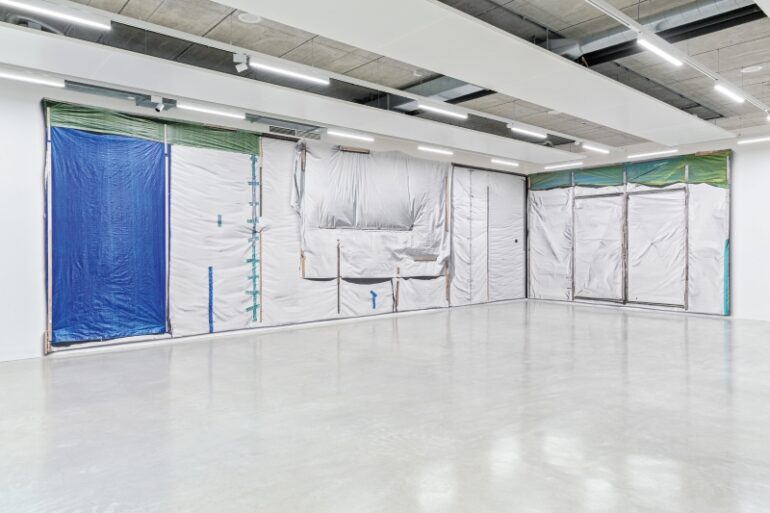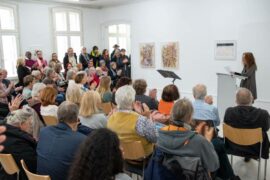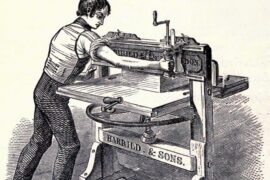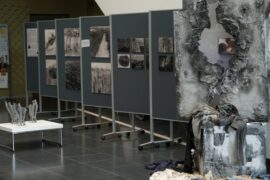How much is needed to enjoy modern art? The Walls at Kunsthaus Göttingen presents three different exhibitions under the same concept where the wall itself acts as a drafting area and the viewer becomes an active participant in the interaction.
By Hanna Vasilevich
Picture: Rauminstallation von Daniela Friebel, © 2022 Emilia Hesse / Steidl Publishers
What happens when the wall interacts with the surrounding space and serves as a working tool? Recently opened at Kunsthaus, the exhibition The Walls of artists Anna-Maria Bogner, Daniela Friebel and Frank Neubauer gives a good reason to reflect upon this concept. According to the curator Ute Eskildsen’s statement in the exhibition booklet, »The Walls is about a direct relationship, about the walls as a drafting area – and working scaffold«. The artists reflect the main idea of the exhibition with different types of modern art (installation, photography, drawing) and, therefore, with contrary concepts and different materials. Each floor is dedicated to one exhibition of a particular artist. The way in which walls and space are perceived as working material is one of the primary questions. Focusing on minimalism, the artists use simple materials, like black rubber bands, photo wallpaper, and graphite, to experiment with space and the viewer’s perception. Dimension, illusion and interaction are key points throughout the entire exhibition.
Reality behind the wall
The photography artwork of Berlin-based artist Daniela Friebel is presented on the first floor. Wood remnants, stamps, tarpaulins, blue sticky tape – that’s what sticks out after coming into the room. The viewer may come up with ideas of what might be hidden behind the tarpaulin until they realize the illusion of the whole picture. As the viewer gets closer, they notice that perspective and lighting change and no longer produce the effect of reality, the picture appears less realistic and the folds and shades do not interact with the light. In fact, it is a photograph depicting pieces of tarpaulins which the artist has photographed in her own city.
The details of the image change while changing the perspective. The concept of the exhibition is identified by discovering the wall as the tool and the material to play with dimension and with the viewer’s expectations. However, a significant transmission occurs when the viewer starts to distinguish the tarpaulin from its photograph on the wall. In such a way, the viewer engages in a dialogue with space in particular and art in general. »I am interested in the questions and observations that arise from this difference«, says Daniela Friebel in the exhibition booklet. The viewer might ultimately conclude that there is a wall behind the wallpaper that also serves as an illustration of the wall. However, there are still many further reflective questions: does the viewer need more details or, in contrast, less details to interact with the artwork? Do they need more colours and larger scale of the tarpaulins on the wall? Should there be more walls covered?
A drawing on the wall – still art?
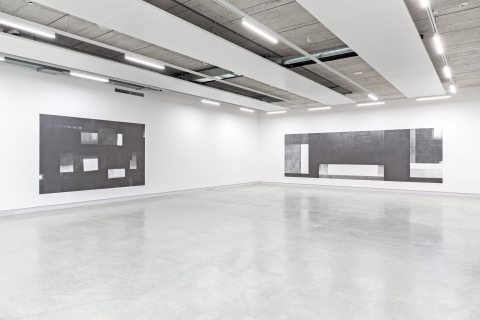
Frank Neubauer’s artwork shows two rectangle drawings depicted right on the wall. Neubauer creates black rectangles with white holes in them using graphite as the drawing medium. The artist’s technique itself reflects the fact that the drawings on the wall can be seen as a contrast to the easily removable paintings in typical museums. Three-dimensional figures create an impression of another reality. Looking at the drawing, the viewer is brought back to reality by pieces of the wall that are visible through the black area of the drawing.
The black rectangles themselves are very strict and reserved in their form and colour which causes a feeling of stiffness, restraint, finiteness. As a result, one may wonder whether they would perceive it as art if it was a real piece of wall? Are the real wall fragments inside the black rectangles identical to those on the outside?
Moving perspective
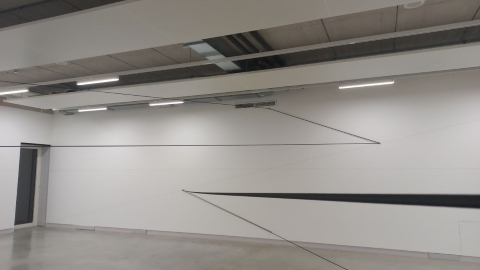
Anna-Maria Bogner from Düsseldorf presents the concept of The Walls using just two rubber bands, coming from opposite corners and crossing in the middle, which divide the room into several impenetrable geometrical parts. It is a rather minimalist display: two bands, an empty room and two colours, black and white. A line that appears closer to the eye and then disappears gives the impression that space is unstable and disorienting, which emphasizes the importance of visual aspects. Moving between the black lines, the viewer discovers space as divided into geometrical parts. The transition from static to dynamic is crucial as while moving and changing the perspective, the viewer perceives the room in a new and different way every time.
One may also notice that the rectangles that the ribbons create are not complete: their parallel lines interfere with the wall, giving a continuation to it. On the one hand, it is a strict and rigid structure, and on the other hand, it is a limitless possibility of interpretations and different perspectives within it.
What does this piece of art tell?
All three exhibitions have their own specific point of view. However, they refer to the main concept of The Walls: all of them are experiments with space and limitations of space whether by drawing on the wall, drawing through the wall or putting wallpaper on the wall. Since something concrete and something abstract are merged to create the drafting area, the wall might be metaphorically considered as the boundary showing where reality ends and art begins.
Sometimes art is difficult to be interpreted because of its complexity and ambiguity, sometimes particular knowledge is required, but sometimes it can be understood without interpretation. The Walls represents a mixture of techniques, styles and materials used in order to find interaction with the addressee. Minimalistic details open, at the same time, an area for play, surprise and experiment. The focus does not have to be drawn to the viewer’s associations with the outside world but to the reality which is right in front of them, namely to what the materials and the tools create.
Info
The Walls runs at Kunsthaus Göttingen until January 8. Opening hours are Thursday from 3 to 6pm and Fridays to Saturdays from 11am to 6pm.
The three pieces of modern art may appear rather hard to perceive and comprehend as it is not very easy to find a particular connection or association with what is familiar to us. However, do we have to? Such experimental art tells a lot about itself by itself. The only thing needed is the viewer’s active participation in this interaction by moving, observing and letting the art speak on its own.


